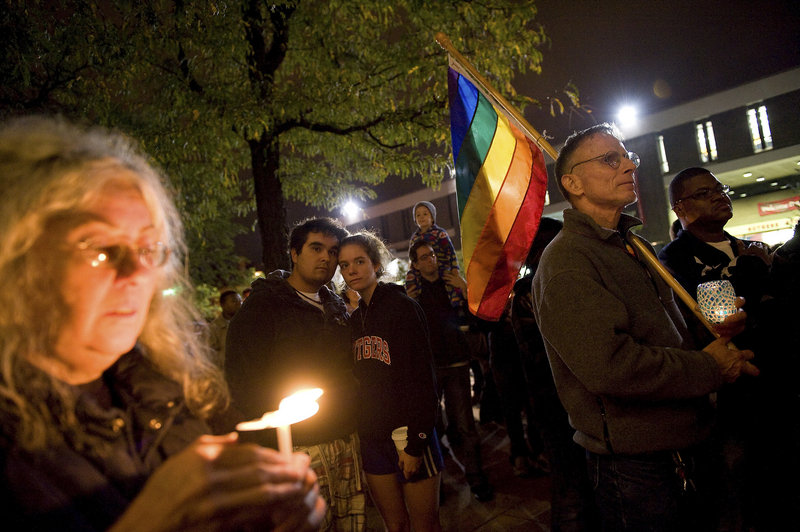PHILADELPHIA – The experts call it “contagion” when a suicide or rash of suicides inspires others to follow in an attempt at martyrdom or solidarity in death.
Most people would call them copycat suicides. Whatever the name, it appears to have been at play in at least one suicide since Rutgers University freshman Tyler Clementi’s highly publicized jump off the George Washington Bridge. And experts fear that other recent suicides might fit the mold or that more are ahead.
That creates a conundrum for advocates who want to stop teenage bullying and their related suicides, as well as for the media outlets that cover them: how to spread the word without romanticizing the problem or unwittingly encouraging vulnerable teenagers to choose death.
“They may see this as a somewhat glamorous ending – that the youth got lots of attention, lots of sympathy, lots of national concern that they never got in life,” said Anara Guard, a senior adviser at the Boston-based Suicide Prevention Resource Center. “The second possible factor is that vulnerable youth may feel like, ‘If they couldn’t cut it, neither can I.”‘
Someone who’s mentally ill may learn about a suicide and consider it a reasonable option, said Madelyn Gould, professor of psychiatry and public health at Columbia University in New York: “A vulnerable person might say, ‘That stopped the pain,”‘ she said.
Experts say that while contagion is a real issue, it’s getting more difficult to identify.
Ann Haas, director of prevention programs at the American Foundation for Suicide Prevention, said that before the Internet, it was relatively easy to track the phenomenon. When several happened within the circulation area of a newspaper, contagion was likely a factor.
But when news knows no geographical boundaries, she said, it’s hard to tell whether the suicides are linked. And Clementi’s death reached farther than most suicide stories do.
Authorities say the 18-year-old killed himself after learning that his Rutgers roommate and another student peeked via webcam as he had an intimate encounter with a man. His death followed a string of suicides by teens nationwide believed to have been bullied for their perceived sexual orientation and quickly became a cause celebre.
A pair of issues long known to gay rights advocates and suicide prevention experts soon became more widely known: Gay, lesbian, bisexual and transgender youth are more likely to attempt suicide than their straight counterparts. And bullied youths are more likely to try suicide than those who aren’t.
“There was no way that Tyler Clementi’s death was not going to be covered,” said Columbia University’s Gould. “He jumped from the George Washington Bridge, and he mobilized the need for a lot of prevention efforts. It’s a good aftermath of a horribly tragic event.”
President Barack Obama and talk show host Ellen DeGeneres posted videos online calling for an end to bullying. Then, last week, a Pennsylvania teenager stepped in front of a tractor-trailer, leaving behind a note saying that he was tired of being called “faggot” and “sissy” – and that he wanted to draw more attention to the problem of bullying.
the count of the American Foundation for Suicide Prevention, it was at least the sixth suicide of a young person in the U.S. who was gay or tormented for being gay since Clementi’s death. Experts wonder whether the latest cases are at least partly reactions to the Rutgers case – and the only people who know for sure are the victims.
Scholars can’t say whether either problem is getting more severe or just more widely reported because no data show what percentage of gay youths or bullying victims are suicidal. Most of the nation’s 34,000 suicides a year don’t get coverage.
Or, perhaps, the suicides are like those that have been happening all along, but these are attracting media attention because of the new focus on the previously neglected problem of bullying-related suicide.
Laura McGinnis, spokeswoman for The Trevor Project, which runs crisis intervention and suicide prevention programs aimed at gay youths, said that since Clementi’s death her group’s crisis hot line has handled about 75 percent more calls than usual. Requests from schools and community leaders for “survival kits” have spiked even more, she said.
Send questions/comments to the editors.



Success. Please wait for the page to reload. If the page does not reload within 5 seconds, please refresh the page.
Enter your email and password to access comments.
Hi, to comment on stories you must . This profile is in addition to your subscription and website login.
Already have a commenting profile? .
Invalid username/password.
Please check your email to confirm and complete your registration.
Only subscribers are eligible to post comments. Please subscribe or login first for digital access. Here’s why.
Use the form below to reset your password. When you've submitted your account email, we will send an email with a reset code.